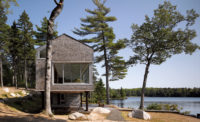In a place where time has seemingly stood still, Sicilian architect Giuseppe Gurrieri has carved a niche for himself with wholly contemporary projects that retain the rustic charm of his birthplace. His most recent, a vacation house for Tuscany-based artist Erica Cavalli in Scicli, a small mountaintop village near his office in Ragusa, is very much a part of the land, and its traditions.
In designing the partially buried abode, Gurrieri took inspiration from the layered, stone-walled agricultural terraces that crisscross the surrounding hills. “The client asked for a house that was integrated with nature,” Gurrieri recalls. The long front facade is clad in stone veneer; its sliding glass doors and full-length windows open up to a lushly landscaped garden and a swimming pool, as well as a view of the sea. The roof of the 1,600-square-foot enclosed portion of the residence, and the area beyond it, is similarly planted with a rich variety of local flowers, grasses, cacti, and shrubs. Behind that simple, barlike structure, which contains a kitchen, two small bedrooms, and a studio-cum-living room, are two sunken courtyards that help naturally ventilate the interiors, which stay inherently cool in summer and warm in winter.
The nearly 11-foot-high walls of the courtyards, which includes one for outdoor dining, are composed of a stucco mix made of soil from the site. “We thought, ‘the more dirt we used, the more integrated with nature the house would be,’ ” says the architect.
The spare interiors feature acid-treated concrete floors and muted beige walls, aside from a pop of color in the studio. Furnishings are kept to a minimum.
Despite its link to the land and its customs, the straightforward design was considered unconventional by the local authorities, who held up building approvals—typically granted in a couple of months—for over a year. “Today, what is simple is really more complex,” Gurrieri says. That may be so, but, in this case, what is simple is also simply stunning.










